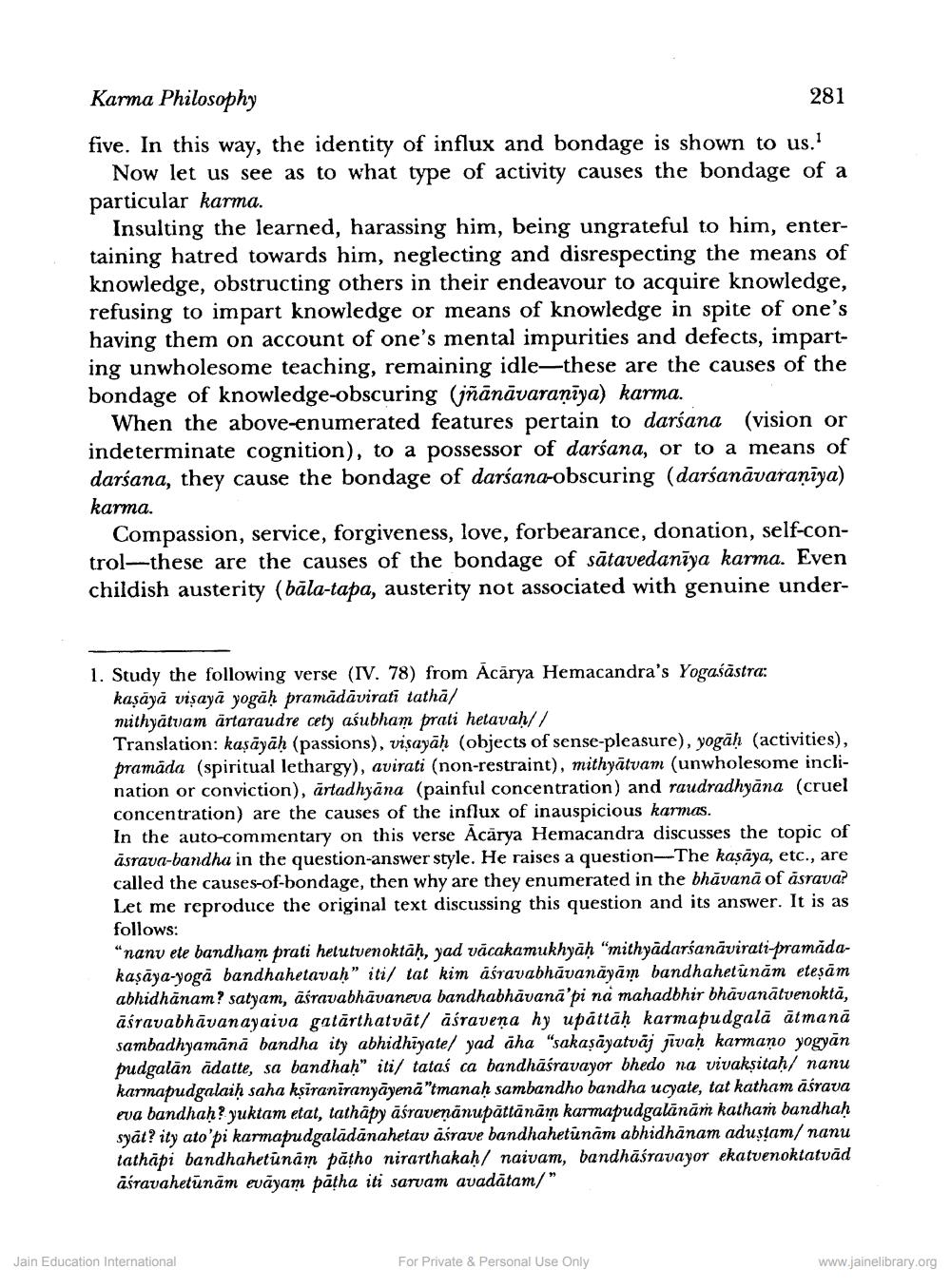________________
Karma Philosophy
281
five. In this way, the identity of influx and bondage is shown to us.'
Now let us see as to what type of activity causes the bondage of a particular karma.
Insulting the learned, harassing him, being ungrateful to him, entertaining hatred towards him, neglecting and disrespecting the means of knowledge, obstructing others in their endeavour to acquire knowledge, refusing to impart knowledge or means of knowledge in spite of one's having them on account of one's mental impurities and defects, imparting unwholesome teaching, remaining idle—these are the causes of the bondage of knowledge-obscuring (jñānāvaraṇīya) karma.
When the above-enumerated features pertain to darśana (vision or indeterminate cognition), to a possessor of darśana, or to a means of darśana, they cause the bondage of darśana-obscuring (darśanāvaraniya) karma.
Compassion, service, forgiveness, love, forbearance, donation, self-control-these are the causes of the bondage of sātavedaniya karma. Even childish austerity (bāla-tapa, austerity not associated with genuine under
1. Study the following verse (IV. 78) from Acārya Hemacandra's Yogaśāstra:
kaşāyā viņayā yogāḥ pramādāvirati tathā/ mithyatyam artaraudre cety aśubham prati hetavah// Translation: kasāyāḥ (passions), visayāḥ (objects of sense-pleasure), yogāh (activities), pramada (spiritual lethargy), avirati (non-restraint), mithyātvam (unwholesome inclination or conviction), ārtadhyāna (painful concentration) and raudradhyāna (cruel concentration) are the causes of the influx of inauspicious karmas. In the auto-commentary on this verse Acārya Hemacandra discusses the topic of asrava-bandha in the question-answer style. He raises a question-The kasāya, etc., are called the causes-of-bondage, then why are they enumerated in the bhāvanā of asrava? Let me reproduce the original text discussing this question and its answer. It is as follows: “nanv ete bandham prati hetutvenoktāh, yad vācakamukhyāḥ "mithyadarśanāvirati-pramădakaşāya-yogā bandhahetavah" iti/ tat kim aśravabhāvanāyām bandhahetünām etesām abhidhānam? satyam, āśravabhāvaneva bandhabhāvanā'pi na mahadbhir bhāvanātvenoktā, aśravabhāvanayaiva gatārthatvät/ aśravena hy upåttāḥ karmapudgalā ātmanā sambadhyamānā bandha ity abhidhiyatel yad āha "sakasāyatvāj jivaḥ karmaṇo yogyān pudgalān adatte, sa bandhah" iti/ tataś ca bandhāśravayor bhedo na vivaksitaḥ/ nanu karnapudgalaiḥ saha kșiraniranyāyenā"tmanaḥ sambandho bandha ucyate, tat katham aśrava eva bandhaḥ? yuktam etat, tathāpy aśravenānupattānām karmapudgalānām katham bandhah syāt?ity ato'pi karmapudgalādānahetav aśrave bandhahetūnām abhidhānam adustam/ nanu tathāpi bandhahetünām patho nirarthakah/ naivam, bandhāśravayor ekatvenoktatvád aśravahetūnām evāyam pātha iti sarvam avadātam/"
Jain Education International
For Private & Personal Use Only
www.jainelibrary.org




